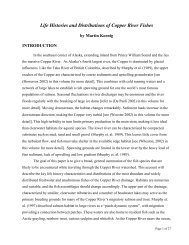Mitigation for the Construction and Operation of Libby Dam
Mitigation for the Construction and Operation of Libby Dam
Mitigation for the Construction and Operation of Libby Dam
You also want an ePaper? Increase the reach of your titles
YUMPU automatically turns print PDFs into web optimized ePapers that Google loves.
Figure 46. Minimal detectible difference <strong>for</strong> Taxa Richness <strong>for</strong> <strong>Libby</strong> Creek. This graph assumes<br />
a= 0.05, <strong>and</strong> b=0.1. With three replicates, <strong>the</strong> taxa richness must increase from 33 to > 46<br />
<strong>for</strong> <strong>the</strong> change to be statistically significant. .....................................................................113<br />
Figure 47. Minimal detectible difference <strong>for</strong> EPT Taxa Richness <strong>for</strong> <strong>Libby</strong> Creek. This graph<br />
assumes a= 0.05, <strong>and</strong> b=0.1. With three replicates, <strong>the</strong> EPT richness must increase from 25<br />
to > 37 <strong>for</strong> <strong>the</strong> change to be statistically significant. .........................................................114<br />
Figure 48. Minimal detectible difference <strong>for</strong> Taxa Richness <strong>for</strong> <strong>the</strong> Grave Creek Phase I<br />
Restoration Project. This graph assumes a= 0.05, <strong>and</strong> b=0.1. With three replicates, <strong>the</strong> taxa<br />
richness must increase from 33 to >41 <strong>for</strong> <strong>the</strong> change to be statistically significant.<br />
Similarly, if 20 samples are collected each year, a change from 33 to 36 taxa becomes<br />
statistically significant. ......................................................................................................115<br />
Chapter 2 Figures<br />
Figure 1. A photograph <strong>of</strong> <strong>the</strong> Eureka fishing pond taken in <strong>the</strong> spring <strong>of</strong> 2003, with <strong>the</strong><br />
polypropylene pond liner installed. The pond has a maximum depth is 8 feet <strong>and</strong> a toal<br />
surface area <strong>of</strong> 0.4 acres. The pond will be stocked <strong>for</strong> recreational family fishing in <strong>the</strong><br />
summer <strong>of</strong> 2004. ................................................................................................................124<br />
Figure 2. Vicinity Map <strong>for</strong> Upper <strong>Libby</strong> Creek Clevel<strong>and</strong> Project. .........................................128<br />
Figure 3. Detailed site location map <strong>of</strong> <strong>the</strong> upper <strong>Libby</strong> Creek Clevel<strong>and</strong> Project Area. ........128<br />
Figure 4. The top cross sectional survey <strong>of</strong> <strong>Libby</strong> Creek (#12C) was surveyed by Montana FWP<br />
in 1999, <strong>and</strong> is typical representation <strong>of</strong> <strong>the</strong> braided channel <strong>and</strong> large amounts <strong>of</strong><br />
deposition within <strong>the</strong> floodplain <strong>of</strong> <strong>the</strong> upper <strong>Libby</strong> Creek Clevel<strong>and</strong> Project site. The<br />
lower figure characterizes <strong>the</strong> design criteria used to implement project construction<br />
activities at this site............................................................................................................129<br />
Figure 5. The longitudinal pr<strong>of</strong>ile <strong>of</strong> <strong>the</strong> existing stream channel prior to <strong>the</strong> implementation <strong>of</strong><br />
<strong>the</strong> restoration project. The survey was conducted beginning at station 0 (upper project<br />
boundary) to approximately 2350 feet prior to <strong>the</strong> implementation <strong>of</strong> <strong>the</strong> restoration project<br />
in <strong>the</strong> fall <strong>of</strong> 2002. The survey was not completed <strong>for</strong> <strong>the</strong> lower approximate third <strong>of</strong> <strong>the</strong><br />
project area. Note <strong>the</strong> lack <strong>of</strong> pool habitat within <strong>the</strong> project area...................................131<br />
Figure 6. The longitudinal pr<strong>of</strong>ile <strong>of</strong> <strong>the</strong> constructed stream channel thalweg in 2002 (as built)<br />
<strong>and</strong> 2003 after <strong>the</strong> project experienced <strong>the</strong> first spring freshet. The survey begins at <strong>the</strong><br />
upper project boundary (station 0) <strong>and</strong> proceeds downstream to <strong>the</strong> lower project boundary<br />
(approximate station 3200). The stream channel prior to channel construction was not<br />
located within <strong>the</strong> same general plan view as <strong>the</strong> newly constructed stream channel.<br />
There<strong>for</strong>e, <strong>the</strong> existing stream channel longitudinal pr<strong>of</strong>ile (Figure 5) could not be<br />
superimposed on this figure due to differences in stream channel length that resulted from<br />
an overall increase in overall channel sinuosity <strong>and</strong> length after project construction. ....132<br />
Figure 7. The longitudinal pr<strong>of</strong>ile <strong>for</strong> <strong>the</strong> Grave Creek Phase I Restoration Project. The survey<br />
was completed be<strong>for</strong>e (2001) <strong>and</strong> after (2002; as built) project completion <strong>and</strong> after <strong>the</strong> first<br />
spring freshet (2003). The station (longitudinal location measured at <strong>the</strong> channel thalweg)<br />
begins at <strong>the</strong> upstream boundary <strong>of</strong> <strong>the</strong> project. ................................................................138<br />
Figure 8. General location map <strong>of</strong> <strong>the</strong> Young Creek State L<strong>and</strong>s Restoration Project area.....141<br />
Figure 9. Detailed location map <strong>of</strong> <strong>the</strong> Young Creek State L<strong>and</strong>s Restoration Project area....141<br />
Figure 10. The longitudinal pr<strong>of</strong>ile <strong>of</strong> <strong>the</strong> reach <strong>of</strong> Young Creek located within <strong>the</strong> State L<strong>and</strong>s<br />
Restoration Project. The survey was completed be<strong>for</strong>e (2002; existing) <strong>and</strong> after (2003;<br />
post-construction) project completion. The station (longitudinal location measured at <strong>the</strong><br />
channel thalweg) begins at <strong>the</strong> upstream boundary <strong>of</strong> <strong>the</strong> project. The as built stream<br />
channel was approximately 250 feet longer due to <strong>the</strong> increased me<strong>and</strong>er frequency that<br />
resulted from constructing <strong>the</strong> new stream channel...........................................................143<br />
11
















